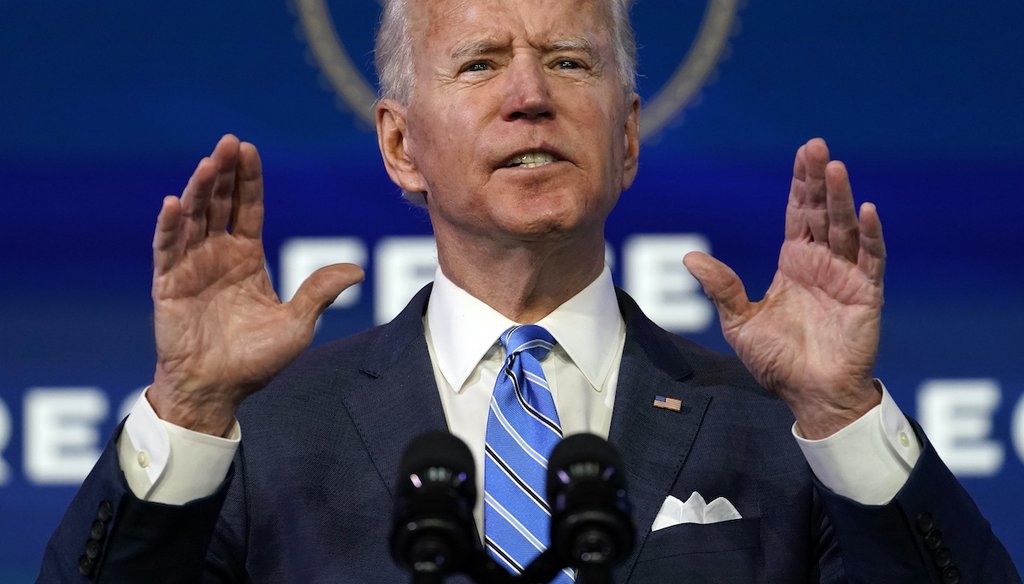Stand up for the facts!
Our only agenda is to publish the truth so you can be an informed participant in democracy.
We need your help.
I would like to contribute

President-elect Joe Biden speaks about the COVID-19 pandemic on Jan. 14, 2021, in Wilmington, Del. (AP)
If Your Time is short
• President-elect Joe Biden has proposed a $1.9 trillion plan for tackling the coronavirus pandemic and related economic challenges.
• Key elements include a $1,400-a-person stimulus payment, enhanced unemployment insurance, aid to state and local governments, a boost for coronavirus vaccination and testing efforts, and aid to schools, child care providers and renters.
• The proposal won plaudits from Democrats and some business groups, but it’s unclear how much of it, if any, can make it through the narrowly divided Senate and House.
Just days away from his inauguration, President-elect Joe Biden proposed a $1.9 trillion plan to help tackle the coronavirus pandemic and the resulting economic recession.
"It's not hard to see that we are in the middle of a once-in-several-generations economic crisis, with a once-in-several-generations public health crisis," Biden said on Jan. 14. "A crisis of deep human suffering is in plain sight. We have to act, and we have to act now. We cannot afford inaction."
Biden called the $935 billion relief bill signed by President Donald Trump on Dec. 27 a first step, but an insufficient one.
Biden’s proposal would be more than double the size of the recovery bill signed by President Barack Obama in 2009 during the Great Recession. The proposal would follow not only the nearly $1 trillion bill signed in December but also the roughly $2 trillion CARES Act signed in March 2020, at the beginning of the pandemic.
Biden’s plan won broad support from Democrats, as well as the conservative-leaning U.S. Chamber of Commerce. "We applaud the President-elect’s focus on vaccinations and on economic sectors and families that continue to suffer as the pandemic rages on," the business group said in a statement. "We must defeat COVID before we can restore our economy, and that requires turbocharging our vaccination efforts."
Sign up for PolitiFact texts
The liberal Center on Budget and Policy Priorities said in a statement that the proposal is "a substantial, responsible plan that would significantly reduce the hardship that millions of people across the country are now facing and will continue to face for some time, given the still-surging virus and stalled economic recovery."
But enacting the full proposal will be a heavy lift. Biden will come into office with the narrowest of Senate majorities and a Democratic majority in the House that is nearly as slim. The plan could also languish in the Senate if the chamber takes up Trump’s impeachment trial early in Biden’s tenure.
Already, some Republicans have criticized the effort for being too expensive. "We have to get serious about how we’re spending taxpayer dollars," Sen. Rick Scott, R-Fla., said in a statement. "We cannot simply throw massive spending at this with no accountability to the current and future American taxpayer."
Here’s a rundown of some of the key elements of Biden’s proposal. The costs listed below are estimates calculated by the Committee for a Responsible Federal Budget and are based on initial reports. These figures may change as the details of the proposal are finalized.
$1,400 stimulus payment
Cost estimate: $465 billion
This direct payment to individuals would come on top of the $600-a-person stimulus payment included in the coronavirus relief bill signed in December. The two payments would add up to $2,000, which is what many Democrats had been pushing for in the original bill, and Trump later advocated. (Some liberal Democrats want to see a full $2,000 in the Biden proposal.)
State and local government aid
Cost estimate: $350 billion
Aid to state and local governments had been one of the biggest sticking points in the negotiations that produced the December bill. Democrats pushed for the funding, but Republicans were reluctant to support what some characterized as bailouts. The December bill ended up including some targeted funding for state and local governments, but the Biden proposal is roughly 10 times bigger than what was in the December bill. It includes a $20 billion carve-out for public transit and $20 billion for tribal governments.
Extend and increase supplemental unemployment insurance
Cost estimate: $350 billion
The December bill extended federal unemployment benefits for 11 weeks. Biden would extend benefits through September, including for self-employed or contract workers who prior to the pandemic would not have qualified for unemployment insurance. The plan would also offer a $400-a-week federal supplement to state unemployment insurance payments, up from the current $300.
Funding for national coronavirus vaccination and testing program
Cost estimate: $160 billion
Amid concerns about the slow distribution of vaccines around the country, Biden would devote $20 billion to a national vaccination program in partnership with states, localities, tribes and territories. "This will include launching community vaccination centers around the country and deploying mobile vaccination units to hard-to-reach areas," the proposal says. It would also spend $50 billion to buy rapid tests, expand lab capacity, and help schools and local governments conduct more tests. The proposal would also fund 100,000 public health workers; focus resources on underserved populations and Americans living in long-term care facilities; and boost spending on identifying new coronavirus strains and procuring supplies.
Funding for K-12 and higher education
Cost estimate: $170 billion
Of this total, $130 billion would go toward enabling K-12 schools to open safely during the pandemic. These funds could go towards reducing class sizes and modifying classroom spaces; improving ventilation; hiring more janitors; purchasing personal protective equipment; increasing transportation capacity; and investing in virtual technology. Another $35 billion would go toward higher education, including financial assistance for students. The remaining $5 billion would go to governors to use for any level of education in their states.
Expanded refundable child tax credit
Cost estimate: $120 billion
The proposal includes a one-year increase of the child tax credit to $3,000 per child (or $3,600 for a child under age 6) and allows 17-year-olds to qualify during that year. (Ordinarily, children have to be under 17.) The tax credit would be fully refundable for households with no tax liability. This is identical to a provision Biden proposed during the presidential campaign.
Rental support
Cost estimate: $30 billion
In addition to extending an existing eviction and foreclosure moratorium through September, Biden’s proposal would give $25 billion (on top of $25 billion in the December bill) to help renters and small landlords with back rent. An additional $5 billion would be earmarked for paying energy and water bills.
Support for child care providers
Cost estimate: $25 billion
The proposal would create a $25 billion fund to assist child-care providers in financial distress, including those facing costs to improve safety amid the pandemic.
Other provisions
Combined cost estimate: $200 billion
- Small business assistance: The proposal includes $15 billion in grants for an estimated 1 million small businesses hit hard by the pandemic. The proposal also envisions leveraging funds given to state and local governments into low-interest loans for small businesses and startups.
- Paid leave: An existing coronavirus pandemic program required emergency paid leave for workers who did not already have such a benefit through their job. But this requirement was not extended by the December bill. The Biden proposal would extend it through the end of September and reimburse employers with fewer than 500 employees, and state and local governments, for the cost.
- Child care assistance: The December bill provided $10 billion to support child care for essential workers. The Biden proposal would add another $15 billion. The proposal would also expand child care tax credit for up to half of their child care spending, up to $4,000 for one child or $8,000 for two or more children, fully refundable.
- Homelessness assistance: The proposal would offer $5 billion for states and localities to help individuals and families who are homeless or at risk of becoming homeless, supporting such options as converting hotels into permanent housing.
- Other assistance to low-income households: Biden would expand the earned income tax credit, which provides low-income workers with additional income through refundable tax credits. The proposal would lift caps on the tax credit for childless adults from about $530 to nearly $1,500, and raise the income limit from about $16,000 to about $21,000. Separately, the proposal would give states an extra $1 billion for temporary cash assistance to low-income households through the Temporary Assistance to Needy Families program; extend a 15% increase in Supplemental Nutrition Assistance Program, or food stamps; and $3 billion for the Women, Infants and Children program.
- Federal minimum wage increase: Biden campaigned on phasing in a minimum wage hike to $15 an hour, and he seeks to do it as part of this proposal.
- Expanded health coverage: The proposal would seek an unspecified subsidy, through the end of September, for COBRA, health insurance coverage for people who have lost a job. It would also seek $20 billion for veterans’ health care and $4 billion for mental health care through the Substance Abuse and Mental Health Services Administration and the Health Resources and Services Administration. The plan also seeks $800 million to help survivors of domestic violence.
- Cybersecurity: The proposal would designate an additional $9 billion for the Cyber Security and Information Security Agency.
Our Sources
Biden-Harris transition team, fact sheet on the American Rescue Plan, Jan. 14, 2021
Committee for a Responsible Federal Budget, "Biden to Unveil $1.9 Trillion COVID Response Plan," Jan. 14, 2021
Committee for a Responsible Federal Budget, "What's in the Final COVID Relief Deal of 2020?" Dec. 21, 2020
CNN, "Here's what's in Biden's $1.9 trillion economic rescue package," Jan. 15, 2021
New York Times, "Biden Outlines $1.9 Trillion Spending Package to Combat Virus and Downturn," Jan. 14, 2021
Washington Post, "Congressional Republicans balk at Joe Biden’s $1.9 trillion relief plan, complicating push for quick passage," Jan. 15, 2021
NPR, "'We Cannot Afford Inaction': Biden Unveils $1.9 Trillion COVID-19 Relief Plan," Jan. 14, 2021
Center on Budget and Policy Priorities, "Parrott: President-Elect Biden’s Relief Plan Meets Urgency of Health and Economic Crisis," Jan. 14, 2021
U.S. Chamber of Commerce, "U.S. Chamber Welcomes President-Elect Biden’s American Rescue Plan," Jan. 14, 2021












































